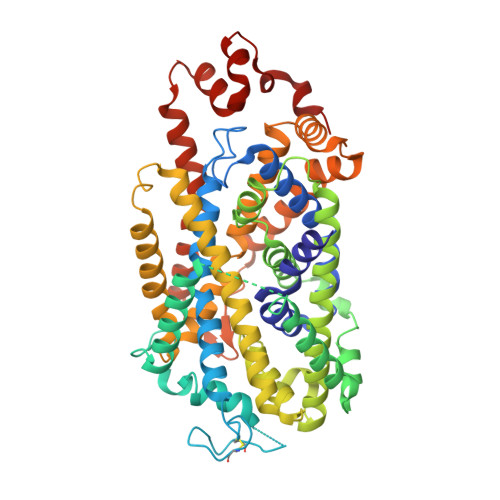Dopamine reuptake and inhibitory mechanisms in human dopamine transporter.
Li, Y., Wang, X., Meng, Y., Hu, T., Zhao, J., Li, R., Bai, Q., Yuan, P., Han, J., Hao, K., Wei, Y., Qiu, Y., Li, N., Zhao, Y.(2024) Nature
- PubMed: 39112701
- DOI: https://doi.org/10.1038/s41586-024-07796-0
- Primary Citation of Related Structures:
8Y2C, 8Y2D, 8Y2E, 8Y2F, 8Y2G - PubMed Abstract:
The dopamine transporter has a crucial role in regulation of dopaminergic neurotransmission by uptake of dopamine into neurons and contributes to the abuse potential of psychomotor stimulants 1-3 . Despite decades of study, the structure, substrate binding, conformational transitions and drug-binding poses of human dopamine transporter remain unknown. Here we report structures of the human dopamine transporter in its apo state, and in complex with the substrate dopamine, the attention deficit hyperactivity disorder drug methylphenidate, and the dopamine-uptake inhibitors GBR12909 and benztropine. The dopamine-bound structure in the occluded state precisely illustrates the binding position of dopamine and associated ions. The structures bound to drugs are captured in outward-facing or inward-facing states, illuminating distinct binding modes and conformational transitions during substrate transport. Unlike the outward-facing state, which is stabilized by cocaine, GBR12909 and benztropine stabilize the dopamine transporter in the inward-facing state, revealing previously unseen drug-binding poses and providing insights into how they counteract the effects of cocaine. This study establishes a framework for understanding the functioning of the human dopamine transporter and developing therapeutic interventions for dopamine transporter-related disorders and cocaine addiction.
Organizational Affiliation:
Key Laboratory of Biomacromolecules (CAS), National Laboratory of Biomacromolecules, CAS Center for Excellence in Biomacromolecules, Institute of Biophysics, Chinese Academy of Sciences, Beijing, China.
















